Abstract
The ability to colonize the small intestine is essential for enterotoxigenic Escherichia coli (ETEC) to cause diarrhea. Several colonization factor antigens (CFAs) and putative colonization factors (PCFs) have been described for ETEC. However, there are still many ETEC strains isolated from patients with diarrhea which do not possess any of these antigens. To identify CFAs in ETEC lacking the above-mentioned antigens, we exploited the ability of ETEC to adhere to tissue-cultured cells from an enterocyte-like cell line, Caco-2. An ETEC strain producing heat-labile toxin and heat-stable toxin of serotype O20:K27:H- (ARG-2) that was isolated from a child with diarrhea in Argentina and bound to Caco-2 cells was studied in further detail. Sodium dodecyl sulfate-polyacrylamide gel electrophoresis (SDS-PAGE) analyses of this strain revealed a band of 25 kDa when bacteria were grown at 37 degrees C that was missing when the same strain was cultured at 20 degrees C. Furthermore, electron microscopy examination revealed the presence of fimbriae on the surfaces of cells of this strain when cells were grown at 37 degrees C but not at 20 degrees C. Rabbit antiserum raised against purified fimbriae reacted with the 25-kDa protein in immunoblotting and bound specifically to the fimbriae, as shown by immunoelectron microscopy. The presence of fimbriae, adhesion to Caco-2 cells, and the 25-kDa band seen in the SDS-PAGE were all simultaneously lost by single-insertion mutations. The N-terminal amino acid sequence of the protein subunit of the fimbriae showed no relation with those of the known colonization factors of ETEC. Furthermore, the fimbriae of the ARG-2 strain did not cross-react immunologically with any of the previously described adhesive factors in human ETEC when specific antisera against colonization factor antigens and putative colonization factors were used. Moreover, a specific antiserum raised against the fimbriae in ARG-2 did not react with ETEC carrying known colonization factors. We propose to name these new fimbriae PCFO20.
Full text
PDF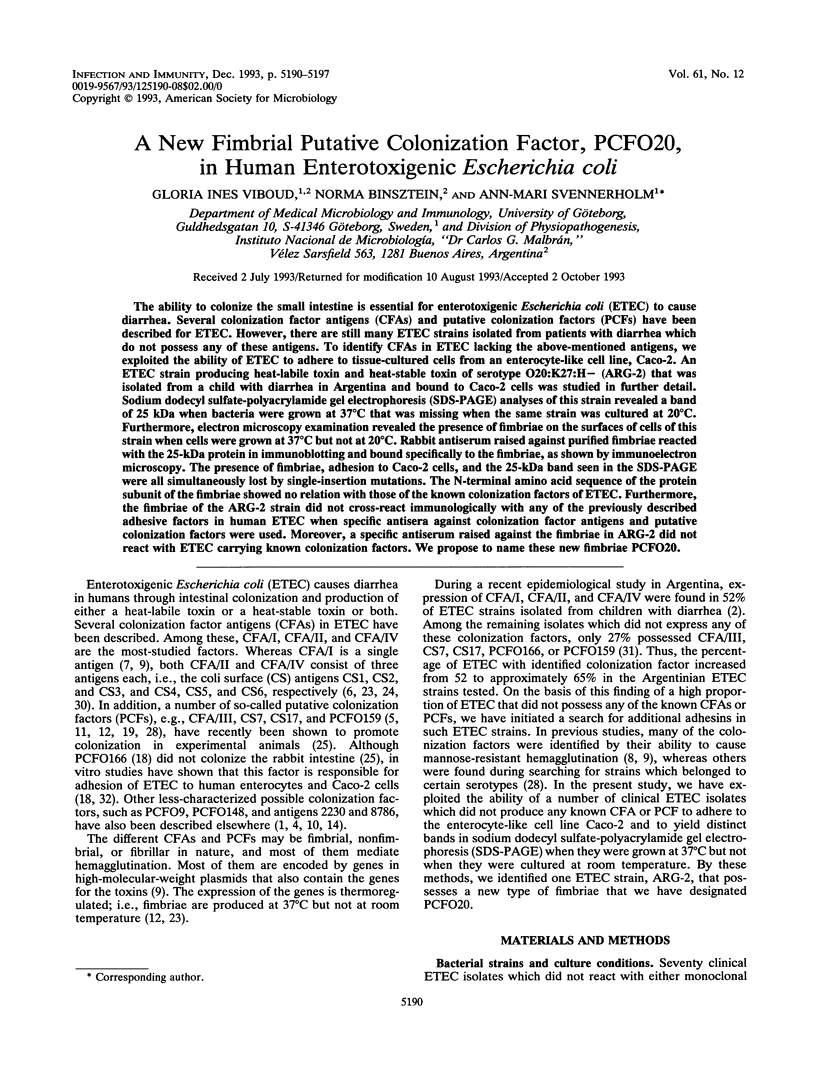

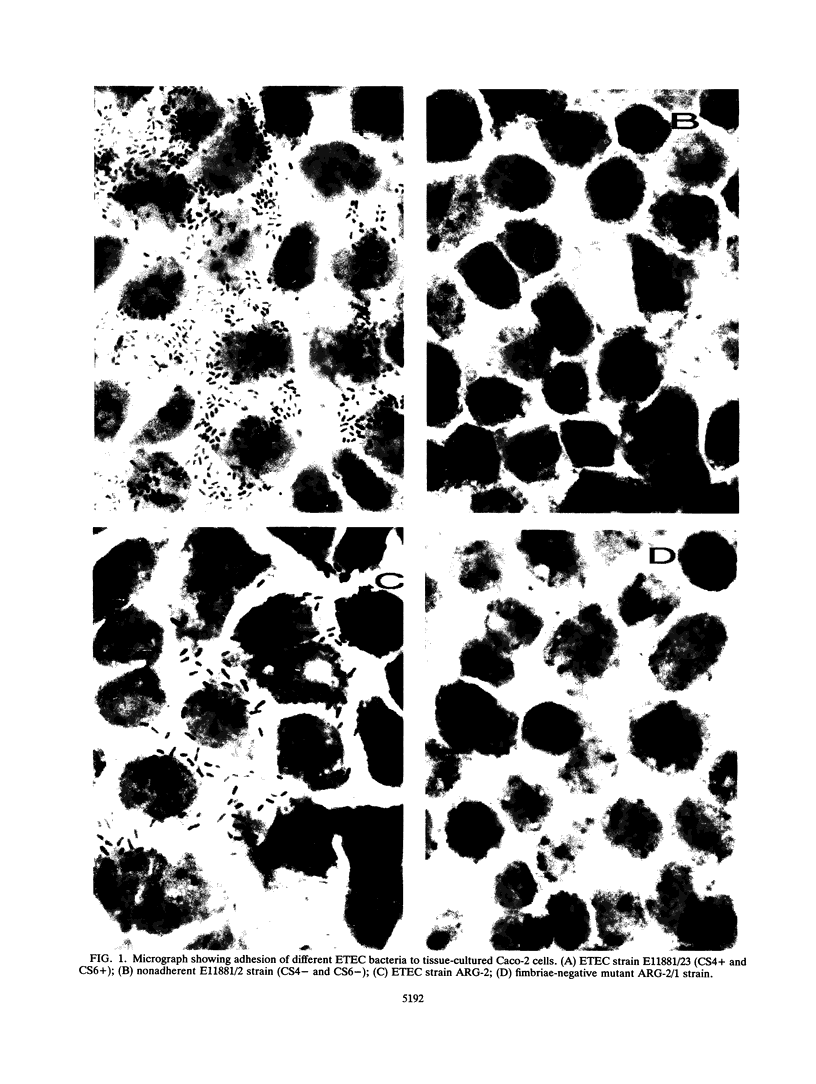

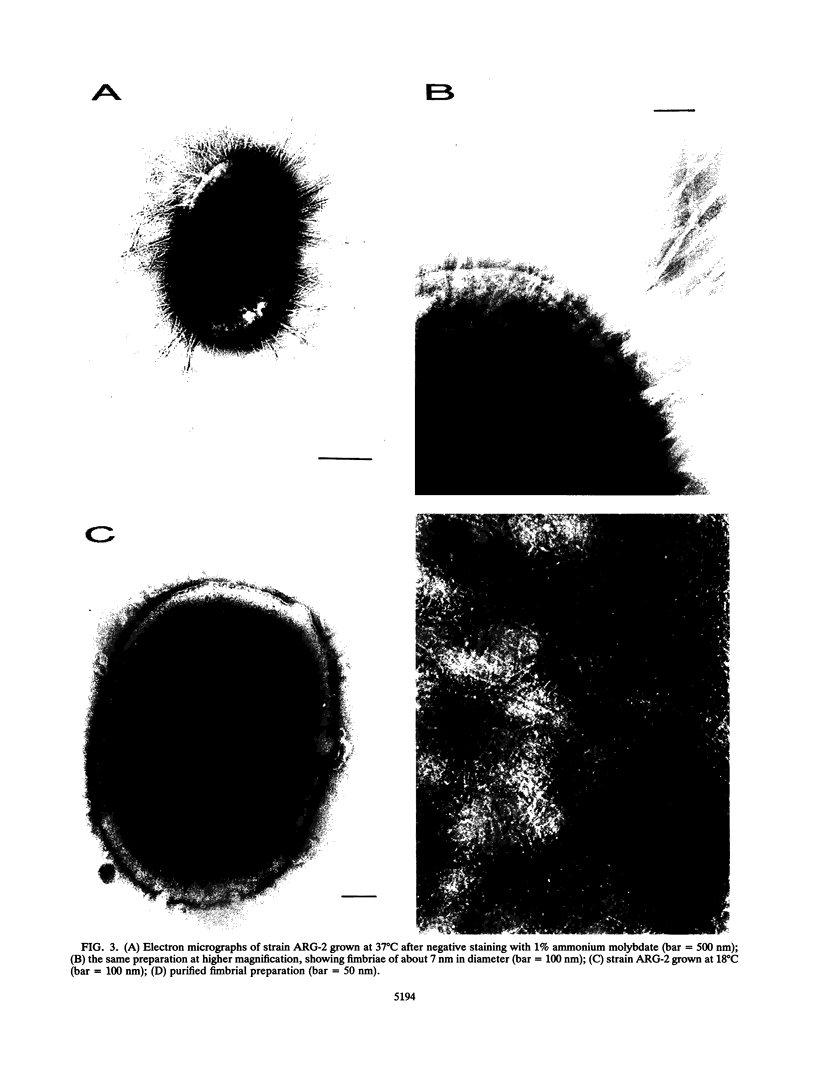
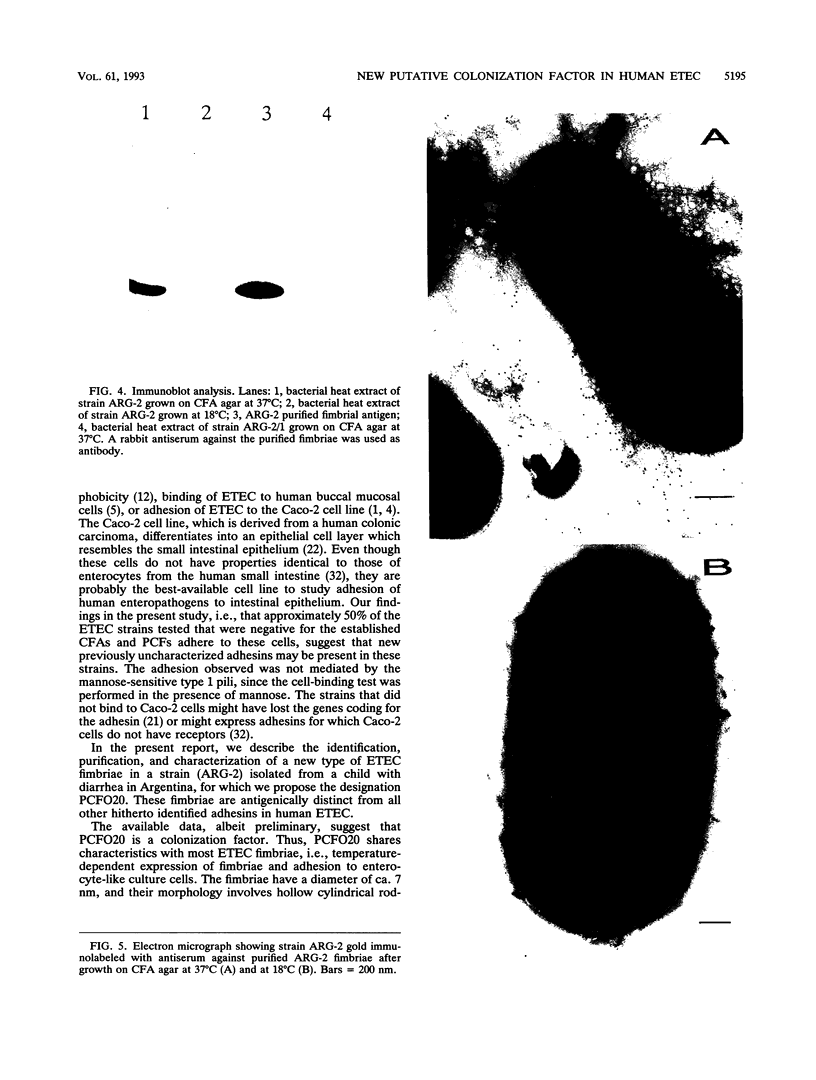
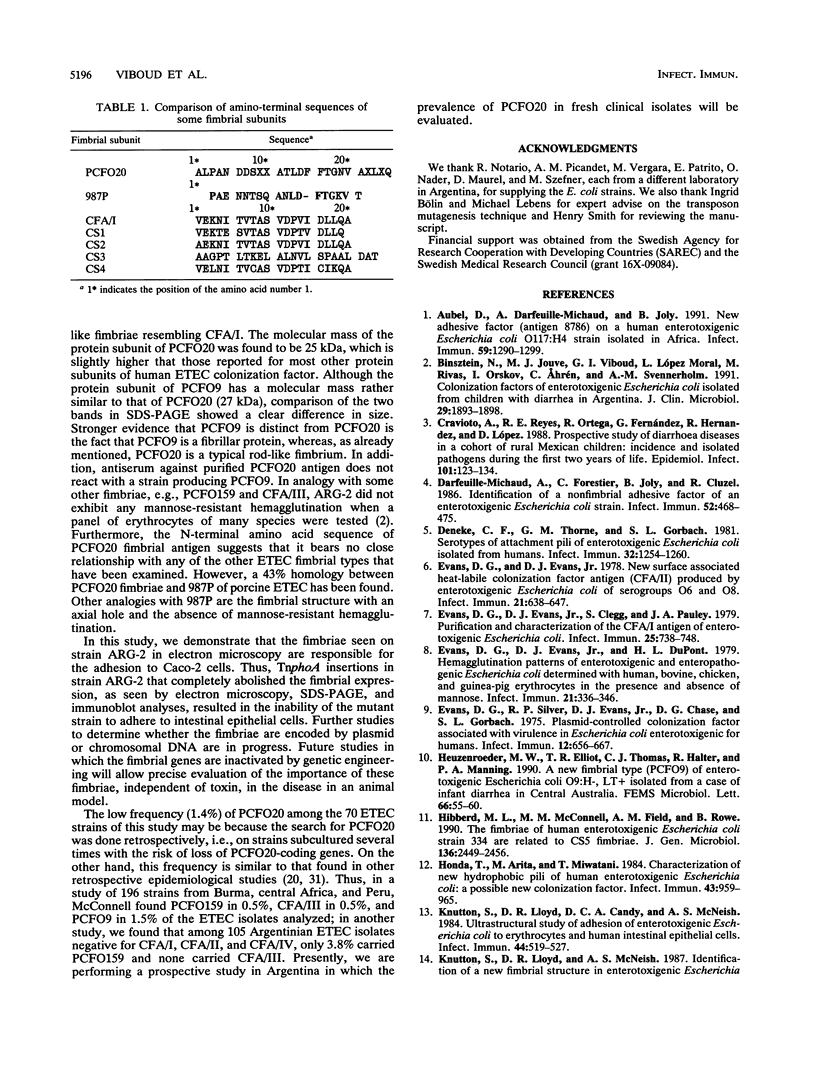

Images in this article
Selected References
These references are in PubMed. This may not be the complete list of references from this article.
- Aubel D., Darfeuille-Michaud A., Joly B. New adhesive factor (antigen 8786) on a human enterotoxigenic Escherichia coli O117:H4 strain isolated in Africa. Infect Immun. 1991 Apr;59(4):1290–1299. doi: 10.1128/iai.59.4.1290-1299.1991. [DOI] [PMC free article] [PubMed] [Google Scholar]
- Binsztein N., Jouve M. J., Viboud G. I., López Moral L., Rivas M., Orskov I., Ahrén C., Svennerholm A. M. Colonization factors of enterotoxigenic Escherichia coli isolated from children with diarrhea in Argentina. J Clin Microbiol. 1991 Sep;29(9):1893–1898. doi: 10.1128/jcm.29.9.1893-1898.1991. [DOI] [PMC free article] [PubMed] [Google Scholar]
- Cravioto A., Reyes R. E., Ortega R., Fernández G., Hernández R., López D. Prospective study of diarrhoeal disease in a cohort of rural Mexican children: incidence and isolated pathogens during the first two years of life. Epidemiol Infect. 1988 Aug;101(1):123–134. doi: 10.1017/s0950268800029289. [DOI] [PMC free article] [PubMed] [Google Scholar]
- Darfeuille-Michaud A., Forestier C., Joly B., Cluzel R. Identification of a nonfimbrial adhesive factor of an enterotoxigenic Escherichia coli strain. Infect Immun. 1986 May;52(2):468–475. doi: 10.1128/iai.52.2.468-475.1986. [DOI] [PMC free article] [PubMed] [Google Scholar]
- Deneke C. F., Thorne G. M., Gorbach S. L. Serotypes of attachment pili of enterotoxigenic Escherichia coli isolated from humans. Infect Immun. 1981 Jun;32(3):1254–1260. doi: 10.1128/iai.32.3.1254-1260.1981. [DOI] [PMC free article] [PubMed] [Google Scholar]
- Evans D. G., Evans D. J., Jr, Clegg S., Pauley J. A. Purification and characterization of the CFA/I antigen of enterotoxigenic Escherichia coli. Infect Immun. 1979 Aug;25(2):738–748. doi: 10.1128/iai.25.2.738-748.1979. [DOI] [PMC free article] [PubMed] [Google Scholar]
- Evans D. G., Evans D. J., Jr New surface-associated heat-labile colonization factor antigen (CFA/II) produced by enterotoxigenic Escherichia coli of serogroups O6 and O8. Infect Immun. 1978 Aug;21(2):638–647. doi: 10.1128/iai.21.2.638-647.1978. [DOI] [PMC free article] [PubMed] [Google Scholar]
- Evans D. G., Silver R. P., Evans D. J., Jr, Chase D. G., Gorbach S. L. Plasmid-controlled colonization factor associated with virulence in Esherichia coli enterotoxigenic for humans. Infect Immun. 1975 Sep;12(3):656–667. doi: 10.1128/iai.12.3.656-667.1975. [DOI] [PMC free article] [PubMed] [Google Scholar]
- Evans D. J., Jr, Evans D. G., DuPont H. L. Hemagglutination patterns of enterotoxigenic and enteropathogenic Escherichia coli determined with human, bovine, chicken, and guinea pig erythrocytes in the presence and absence of mannose. Infect Immun. 1979 Feb;23(2):336–346. doi: 10.1128/iai.23.2.336-346.1979. [DOI] [PMC free article] [PubMed] [Google Scholar]
- Heuzenroeder M. W., Elliot T. R., Thomas C. J., Halter R., Manning P. A. A new fimbrial type (PCFO9) on enterotoxigenic Escherichia coli 09:H- LT+ isolated from a case of infant diarrhea in central Australia. FEMS Microbiol Lett. 1990 Jan 1;54(1-3):55–60. doi: 10.1016/0378-1097(90)90258-r. [DOI] [PubMed] [Google Scholar]
- Hibberd M. L., McConnell M. M., Field A. M., Rowe B. The fimbriae of human enterotoxigenic Escherichia coli strain 334 are related to CS5 fimbriae. J Gen Microbiol. 1990 Dec;136(12):2449–2456. doi: 10.1099/00221287-136-12-2449. [DOI] [PubMed] [Google Scholar]
- Honda T., Arita M., Miwatani T. Characterization of new hydrophobic pili of human enterotoxigenic Escherichia coli: a possible new colonization factor. Infect Immun. 1984 Mar;43(3):959–965. doi: 10.1128/iai.43.3.959-965.1984. [DOI] [PMC free article] [PubMed] [Google Scholar]
- Knutton S., Lloyd D. R., Candy D. C., McNeish A. S. Ultrastructural study of adhesion of enterotoxigenic Escherichia coli to erythrocytes and human intestinal epithelial cells. Infect Immun. 1984 May;44(2):519–527. doi: 10.1128/iai.44.2.519-527.1984. [DOI] [PMC free article] [PubMed] [Google Scholar]
- Knutton S., Lloyd D. R., McNeish A. S. Identification of a new fimbrial structure in enterotoxigenic Escherichia coli (ETEC) serotype O148:H28 which adheres to human intestinal mucosa: a potentially new human ETEC colonization factor. Infect Immun. 1987 Jan;55(1):86–92. doi: 10.1128/iai.55.1.86-92.1987. [DOI] [PMC free article] [PubMed] [Google Scholar]
- Laemmli U. K. Cleavage of structural proteins during the assembly of the head of bacteriophage T4. Nature. 1970 Aug 15;227(5259):680–685. doi: 10.1038/227680a0. [DOI] [PubMed] [Google Scholar]
- López-Vidal Y., Calva J. J., Trujillo A., Ponce de León A., Ramos A., Svennerholm A. M., Ruiz-Palacios G. M. Enterotoxins and adhesins of enterotoxigenic Escherichia coli: are they risk factors for acute diarrhea in the community? J Infect Dis. 1990 Aug;162(2):442–447. doi: 10.1093/infdis/162.2.442. [DOI] [PubMed] [Google Scholar]
- Manoil C., Beckwith J. TnphoA: a transposon probe for protein export signals. Proc Natl Acad Sci U S A. 1985 Dec;82(23):8129–8133. doi: 10.1073/pnas.82.23.8129. [DOI] [PMC free article] [PubMed] [Google Scholar]
- McConnell M. M., Chart H., Field A. M., Hibberd M., Rowe B. Characterization of a putative colonization factor (PCFO166) of enterotoxigenic Escherichia coli of serogroup O166. J Gen Microbiol. 1989 May;135(5):1135–1144. doi: 10.1099/00221287-135-5-1135. [DOI] [PubMed] [Google Scholar]
- McConnell M. M., Hibberd M. L., Penny M. E., Scotland S. M., Cheasty T., Rowe B. Surveys of human enterotoxigenic Escherichia coli from three different geographical areas for possible colonization factors. Epidemiol Infect. 1991 Jun;106(3):477–484. doi: 10.1017/s0950268800067522. [DOI] [PMC free article] [PubMed] [Google Scholar]
- McConnell M. M., Hibberd M., Field A. M., Chart H., Rowe B. Characterization of a new putative colonization factor (CS17) from a human enterotoxigenic Escherichia coli of serotype O114:H21 which produces only heat-labile enterotoxin. J Infect Dis. 1990 Feb;161(2):343–347. doi: 10.1093/infdis/161.2.343. [DOI] [PubMed] [Google Scholar]
- McConnell M. M., Thomas L. V., Willshaw G. A., Smith H. R., Rowe B. Genetic control and properties of coli surface antigens of colonization factor antigen IV (PCF8775) of enterotoxigenic Escherichia coli. Infect Immun. 1988 Aug;56(8):1974–1980. doi: 10.1128/iai.56.8.1974-1980.1988. [DOI] [PMC free article] [PubMed] [Google Scholar]
- Smyth C. J. Two mannose-resistant haemagglutinins on enterotoxigenic Escherichia coli of serotype O6:K15:H16 or H-isolated from travellers' and infantile diarrhoea. J Gen Microbiol. 1982 Sep;128(9):2081–2096. doi: 10.1099/00221287-128-9-2081. [DOI] [PubMed] [Google Scholar]
- Svennerholm A. M., McConnell M. M., Wiklund G. Roles of different putative colonization factor antigens in colonization of human enterotoxigenic Escherichia coli in rabbits. Microb Pathog. 1992 Nov;13(5):381–389. doi: 10.1016/0882-4010(92)90081-x. [DOI] [PubMed] [Google Scholar]
- Svennerholm A. M., Vidal Y. L., Holmgren J., McConnell M. M., Rowe B. Role of PCF8775 antigen and its coli surface subcomponents for colonization, disease, and protective immunogenicity of enterotoxigenic Escherichia coli in rabbits. Infect Immun. 1988 Feb;56(2):523–528. doi: 10.1128/iai.56.2.523-528.1988. [DOI] [PMC free article] [PubMed] [Google Scholar]
- Svennerholm A. M., Wiklund G. Rapid GM1-enzyme-linked immunosorbent assay with visual reading for identification of Escherichia coli heat-labile enterotoxin. J Clin Microbiol. 1983 Apr;17(4):596–600. doi: 10.1128/jcm.17.4.596-600.1983. [DOI] [PMC free article] [PubMed] [Google Scholar]
- Svennerholm A. M., Wikström M., Lindblad M., Holmgren J. Monoclonal antibodies against Escherichia coli heat-stable toxin (STa) and their use in a diagnostic ST ganglioside GM1-enzyme-linked immunosorbent assay. J Clin Microbiol. 1986 Oct;24(4):585–590. doi: 10.1128/jcm.24.4.585-590.1986. [DOI] [PMC free article] [PubMed] [Google Scholar]
- Tacket C. O., Maneval D. R., Levine M. M. Purification, morphology, and genetics of a new fimbrial putative colonization factor of enterotoxigenic Escherichia coli O159:H4. Infect Immun. 1987 May;55(5):1063–1069. doi: 10.1128/iai.55.5.1063-1069.1987. [DOI] [PMC free article] [PubMed] [Google Scholar]
- Taylor R. K., Manoil C., Mekalanos J. J. Broad-host-range vectors for delivery of TnphoA: use in genetic analysis of secreted virulence determinants of Vibrio cholerae. J Bacteriol. 1989 Apr;171(4):1870–1878. doi: 10.1128/jb.171.4.1870-1878.1989. [DOI] [PMC free article] [PubMed] [Google Scholar]
- Thomas L. V., McConnell M. M., Rowe B., Field A. M. The possession of three novel coli surface antigens by enterotoxigenic Escherichia coli strains positive for the putative colonization factor PCF8775. J Gen Microbiol. 1985 Sep;131(9):2319–2326. doi: 10.1099/00221287-131-9-2319. [DOI] [PubMed] [Google Scholar]
- Viboud G. I., Binsztein N., Svennerholm A. M. Characterization of monoclonal antibodies against putative colonization factors of enterotoxigenic Escherichia coli and their use in an epidemiological study. J Clin Microbiol. 1993 Mar;31(3):558–564. doi: 10.1128/jcm.31.3.558-564.1993. [DOI] [PMC free article] [PubMed] [Google Scholar]







